
What’s Behind Union Decline in the United States?
I understand that union membership has been going down in the United States since the 1980s. How much have unions shrunk?
The total number of union members in the United States peaked in the late 1970s and early 1980s, at over 20 million. As of 2010, it remained near 15 million. The story of union decline in the United States, however, does not begin in the 1980s, nor is it as modest as these figures would suggest.
Union density (or the “unionization rate”), the number of workers who are members of unions as a percentage of total employment, has been declining in the United States for over half a century. The share of U.S. workers in unions peaked in 1954, at just over one fourth of employed workers. For nonagricultural workers, the high-water mark—at more than one third of employed workers—came even earlier, in 1945. It would reach nearly the same percentage again in the early 1950s, before beginning a long and virtually uninterrupted decline.
By 2010, the unionization rate for employed workers was less than 12%. The percentage would be even lower were it not for increasing unionization among public-sector workers since the 1960s. For employed private-sector workers, the unionization rate is now less than 7%.
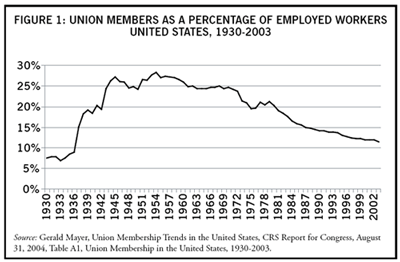
What are the main reasons for union decline? Is it just that there are no manufacturing jobs anymore?
There are multiple reasons for union decline, including declines in employment in highly unionized industries, declines in unionization rates within these traditional bastions of unionism, and failures to unionize in new, growing sectors.
In the heyday of U.S. unions, from the 1940s through the 1960s, union membership was concentrated in the “core” sectors of manufacturing, construction, mining, and transportation. In the early 1950s, unions included over 40% of workers in manufacturing, over 60% in mining, and over 80% in both construction and transportation/ communications/ utilities.
Total employment levels in manufacturing, mining, and utilities have declined dramatically in recent decades. Employment in manufacturing was much larger, at its peak, than in these other sectors. Its decline, from over 19 million workers in the late 1970s to less than 12 million today, is paralleled by smaller absolute declines in mining and utilities. Increasing mechanization and automation are a big part of the reason for the long-term employment declines in manufacturing and other former core sectors. Increased imports and “offshoring” of production are also factors.
The graph below shows the difference, for selected industries, between actual union membership in 2010 and what it would have been if total employment and industry unionization rates were as in 2010, but the distribution of employment among different industries was as in 1983. (A comparison with the early 1950s would have been preferable, but consistent data are not available going back that far.) As the graph shows, union membership is lower now than it would have been in sectors with declining employment, with the largest “losses” in manufacturing, mining, utilities, and wholesale trade.
Meanwhile, however, union membership is higher now that it would have been in sectors with increasing employment, with the largest “gains” in public administration, retail, education, transportation, and health care. The losses in the declining-employment sectors are partly offset by gains in the increasing-employment sectors. (Remember that “gains” and “losses” refer to the difference between actual union membership and hypothetical levels, if the employment structure had remained as in 1983.) While the losses in the main losing sectors are greater than the gains in the main gaining sectors, and much larger if we look only at the private sector, the changes in employment structure only explain a fraction of the decline in union membership.
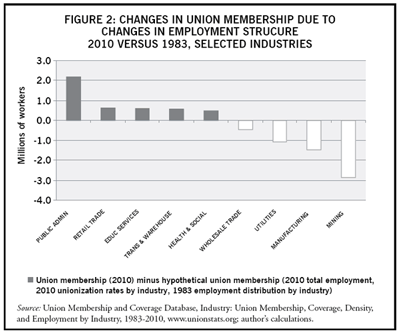
If it’s not the loss of manufacturing jobs, what are the main causes of union decline?
Unionization rates have declined dramatically across most industries, including in what were traditionally highly unionized sectors. In manufacturing and transportation/ communications/ utilities, the unionization rates in 2000 were less than one third what they had been a half century before; in construction, less than one fourth; in mining, barely one sixth.
Declining unionization rates account for much of the overall decline in union membership. The graph below shows the difference, for selected industries, between union membership now and what it would have been, with total employment and the employment structure as they are now, but with industry unionization rates from 1983. Since unionization rates have declined in almost all industries, we see union “losses” running across nearly all the industries shown, with the only exception being public administration. The largest losses come in traditional union strongholds: manufacturing, transportation, and construction. Notice, however, that there are also losses in growing industries: health care, retail, hotels and restaurants, and education. (Remember, again, that “losses” here compare actual union membership to what it would have been, given current industry employment, but 1983 unionization rates. In fact, total union memberships in health care, education, and hotels and restaurants have increased, due to increasing employment in these sectors.)
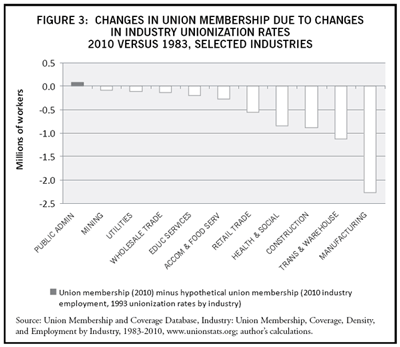
Why have unionization rates declined?
Employers’ determination to rid themselves of unions has certainly played a major role in declining unionization rates. Where employers could not break unions by frontal assault, they were determined to find ways around them. Unionized companies established parallel non-union operations, a practice sometimes known as “double breasting,” gradually shifting production and employment away from their unionized facilities. Some employers began contracting out work, formerly done by union employees, to non-union subcontractors (the original meaning for “outsourcing”). Some established new operations far from their traditional production centers, especially in less unionized and lower-wage areas. Many companies based in the Northeast and Upper Midwest, for example, set up new production sites in the U.S. South and West, and eventually in other countries. (For a great historical account on one company, see Jefferson Cowie’s Capital Moves: RCA’s 70-Year Quest for Cheap Labor.) Finally, new employers entered highly unionized sectors, but most often remained non-union. The auto industry is a good example. So-called “transplants” (factories owned by non-U.S. headquartered companies) have accounted for an increasing share of the industry’s shrinking labor force, and have remained largely non-union.
You also mentioned failures to organize unions in industries were employment is growing. Why is that?
Historically, union growth has come primarily in short spurts when unions expand into new industries. Since the 1940s, however, U.S. unions have failed to organize in growing industries to compensate for the declines in employment and unionization rates in traditional union strongholds. The one major exception has been unionization, since the 1960s, among public-sector employees. Since the early 1970s, union density for public-sector workers has increased from about 20% to over 35%. This has not been nearly enough, however, to counteract the decline among private-sector workers. To maintain the overall unionization rates of the 1950s or 1960s, unions would have had to enlist millions more workers in the private sector, especially in services.
We should not assume that the explanation for the lack of new organization in growing private-sector industries is simply that workers do not want unions. In fact, polling data from 1984 to 2004 show an increasing percentage of non-union workers would have voted to form a union, if given the opportunity to vote in a secret-ballot election. In 1984, less than one third of non-union workers would have “definitely or probably” voted to form a union. Two decades later, more than half of non-union workers would have. Meanwhile, the percentage that would have “definitely or probably” voted against a union declined from nearly two thirds to a little more than one third.
It is clear, on the other hand, that employers have turned sharply against unions. In the 1930s and 1940s, many employers accepted unions, grudgingly, as a way to ease labor unrest. As much as employers might dislike unions and collective bargaining, they were preferable to strikes or even factory occupations (or “sit downs”). Since the 1970s, however, employers have fought unions and unionization drives with increasing aggressiveness, as part of what labor historian Michael Goldfield calls the “employer offensive.” In the early 1970s, Goldfield notes, about 15% of National Labor Relations Board (NLRB)-supervised union elections were so-called “consent elections,” in which employers had come to a prior agreement with the union(s) on the terms of the election. Historically, unions are more likely to win consent elections than elections in which the employer formally disputes the terms of the election, such as the group of workers (or “bargaining unit”) that has the right to vote and will have union representation if the union wins. By the early 1980s, only about 3% of NLRB elections were consent elections.
In addition, employers increasingly sought to delay union elections. Goldfield shows that, the longer the delay between an organizing campaign and election, the lower the likelihood of union victory. Partly, this may be due to a predictable decline in enthusiasm, with the passage of time since the beginning of a unionization campaign. It is also due, however, to employer intimidation of union supporters in the time between unionization campaigns and elections. In many unionization campaigns, employers fire vocal union supporters, both eliminating pro-union campaigners and making other workers afraid of being fired as well. Researchers at the Center for Economic and Policy Research (CEPR) have found that, between 2001 and 2005, pro-union workers were illegally fired in around one fourth of all union election campaigns. Meanwhile, in many campaigns, employers threaten that, if the union wins, the workplace will be shut down (at least in part) and workers will lose their jobs. Labor researcher Kate Bronfenbrenner reports, in a study from the mid 1990s, that employers threatened plant closings in more than half of all unionization campaigns, and that such threats cut the union victory rate (compared to those in which no such threat was made) by about 30%.
Aren’t there labor laws that protect workers’ rights—to join unions, bargain collectively, and even go out on strike? Are employers really allowed to engage in these kinds of intimidation tactics?
There are labor laws, but these protections are not always strong enough, and they are not always enforced. The employer offensive has unfolded, especially since the 1980s, against a backdrop of government hostility towards unions. Unions and pro-union commentators have argued that, since the 1980s, the federal government has often turned a blind eye to illegal tactics (or “unfair labor practices”) routinely used by employers to fight unionization drives. Employer retaliation against workers (by firing or otherwise) for union membership, union activity, or support for unionization is illegal. An employer threat to close a specific plant, in response to a unionization drive, is also illegal. However, union supporters argue, the government agencies tasked with enforcing labor law have ignored such practices, imposed only “slap on the wrist” punishments, or delayed judgment, sometimes for years, long after the unionization campaign is over and done with.
Many labor historians point to the Reagan administration’s mass firing of striking air-traffic controllers (members of the Professional Air Traffic Controllers Organization, or PATCO) in 1981 as a signal to private employers that the federal government approved of their own “union busting” activities. Before the PATCO strike, it was relatively rare for employers to fire striking workers and hire “permanent replacements.” (Sometimes, employers would bring in replacements during a strike, but striking workers would get their jobs back after a settlement was reached.) After PATCO, private employers responded to strikes, with increased frequency, by firing the strikers and bringing in permanent replacements—a practice that is illegal in many countries, but not in the United States. The number of large strikes, already in sharp decline during the preceding few years (possibly due to the employer offensive, rising unemployment, and other factors), has since declined to microscopic proportions.
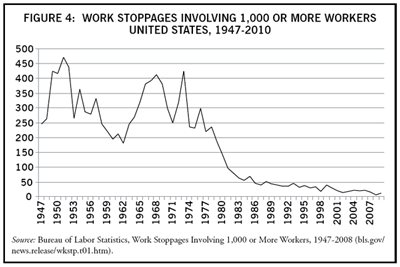
But employers and the government have opposed unions in the past, too, and still unions have had periods of growth. Are unions doing something wrong, now, that explains the failure to organize new workers?
Pro-labor and pro-union commentators have been among those most critical of U.S. unions and their leaderships for not devoting themselves sufficiently to new organizing. Union leaderships, they argue, have been largely content to mark the time between one bargaining period and the next, collecting dues from their existing memberships, even as the number of union members dwindled. Moreover, the whole spirit of the labor movement changed in ways that made new organizing more difficult.
Unions were built, economic historian Gerald Friedman argues, primarily through mass upsurges by workers themselves. They grew the most during waves of strikes and other dramatic bursts of collective action. They were mass social movements. Over time, however, this spirit waned. Union members became less active in the unions, and unions played smaller and smaller roles in the lives of their members. Union leaderships usually did not seek to encourage members’ active involvement, which they saw as a threat to their authority. Leaders embraced “business” or “service” models of unionism: Workers hired a union to represent them at the bargaining table and get them a better deal, or to argue their side in disputes with management, much as one would hire a lawyer or an insurance company. That is hardly a vision to inspire great movements of people.
Well, are there any prospects for a union revival?
Union decline is not a uniquely U.S. phenomenon. Union densities, Friedman notes, have declined in almost all rich capitalist countries. In some countries, however, unions have been relatively successful in new organizing, and the declines have been modest. The decline has been greater in the United States than almost anywhere else. Partly this is due to an especially negative environment for both existing unions and new organizing, and partly to the weaknesses of organized labor itself. Changes in labor law, or even in the enforcement of existing labor law, could make the organizing environment more favorable.
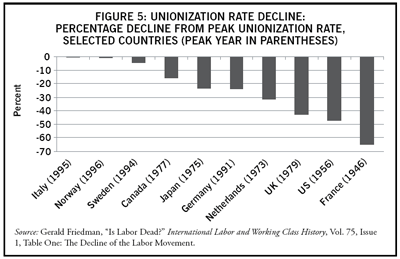
The weakness of the organized labor movement as a political force and the absence of a major labor-based, social democratic, or socialist political party (unlike in most rich capitalist countries), however, makes these kinds of public policy changes less likely. The failure of the U.S. union movement to win labor-law reforms during the current administration, especially long-sought legislation that would have required employers to bargain with a union as soon as a majority of the workers signed union cards (known as the Employee Free Choice Act), reflects this weakness. Meanwhile, several state administrations have launched a new wave of attacks on labor rights, particularly the collective-bargaining rights of public-sector workers.
At this point, unions in the United States—including less than a tenth of private-sector workers—are almost back down to the level they were at the beginning of the Great Depression. The 1930s turned out to be the greatest period of greatest union growth in U.S. history, with substantial additional growth in the 1940s and 1950s largely an aftershock of that earlier explosion. There is no guarantee, however, that history will repeat itself, and that the weakness of organized labor today will give way to a new burst of energy. In the midst of a deep recession, and now the beginnings of a halting recovery, there have been few signs of a labor revival. Ironically, only the recent attacks on public-sector workers and unions have provoked a mass-movement fight-back. Labor supporters, however, should understand this, soberly, as coming from a very defensive position.
Did you find this article useful? Please consider supporting our work by donating or subscribing.
